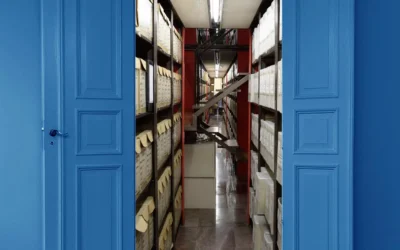Determining Your Archival Project Budget
Margot Note
An archival project should be completed without exceeding authorized expenditures. Many projects in archives lack a direct profit motive. For these projects, even in the absence of monetary gain, careful attention to financial management is vital.
Project managers need to know what a project will cost. However, accurate cost estimating is difficult because it begins before all the information about the project is available. You develop a budget in stages—from an initial estimate, to a detailed estimate, to an approved budget. You may revise your budget while your project is in progress. The less defined the project, the greater the chance that the estimated costs will differ from the final numbers. The variance, unfortunately, is often on the side of a cost overrun.
Sometimes projects are supported by influential people within the organization, so it’s challenging to make an unbiased appraisal. Conflicting values and loyalties may exaggerate the expected benefits. Applying financial tests ensures that decisions made about investment in the project will endure scrutiny.
Valid Project Costs
Project managers must provide valid project costs to sponsors so they can decide whether the project should proceed. Don’t be intimidated into committing to a lower value than is possible. It’s far wiser to present realistic costs than to underestimate and set yourself up for problems in the future. Archivists must often defend our labor costs, so don’t back down in presenting your estimates.
When first determining the budget, consider the constraints. How much money is available? When should the project be completed? What internal resources are required? What external resources are needed, and what will they cost? What are you willing to settle for that will still meet your needs? Is there a way to complete the project using less expensive or fewer resources?For large projects, such as the construction of a conservation lab or the development of a research institute, the project team should work with the organization’s development office to begin fundraising efforts. The focus should be on the capital campaign, but the project manager should also push for endowments to pay for costs beyond the life of the project.
Payment Approaches
It’s also helpful to review payment approaches and how they can influence your budget. Standard methods are payment upon delivery, payment on a schedule, payment on a schedule with variable payments, and payment on milestones when deliverables are produced and verified.
Payment upon delivery is straightforward. When you receive a product, you confirm its validity and acceptability. The vendor then submits an invoice on pre-agreed terms. As project manager, you will have planned for the appropriate funds to pay for the product.
Payment on a schedule is also uncomplicated. This approach is used when you’re procuring workers on an ongoing time and materials basis. The outsourcing firm will take the hours claimed for your project and submit an invoice. You determine the accuracy of the hours worked, ensure you’re getting the quality expected, and confirm the invoices’ validity. These payments can also be planned by predicting the hours you expect to be billed and including the budgeted amount in your project cost plan.
Payment on a schedule with variable payments is handled similarly to the previous approach because the scheduled set of payments are made. The variable payment portion occurs when the amount of work required is based on a forecast. A base monthly fee is necessary for the service of handling orders with a potential rebate or additional payment, if the forecast volume varies from a given baseline workload. In this case, you plan the scheduled payments, and you watch how the workload volumes progress. Adjust your payment schedule quarterly.
Finally, the payment on a milestone approach relates to your project schedule. Aspects of what you require your vendor or partner to do are delivered in parts that should be captured in your project schedule. Payment on milestone is a fixed amount, so it is straightforward to include it in your budget. Verification of the deliverable against the milestone can sometimes take, so the period to perform that task should be included in your schedule.
Payment Flexibility
Your payment timing to vendors can affect archival project costs and the financial state of your organization. Depending on the sizes of the purchases, they can have consequences on your budget. Your organization may direct you to delay buying something until the next accounting period. Conversely, they may want to spend money now rather than wait, so the budget allocation remains the same in the next fiscal year or quarter.
Given these circumstances, it’s wise to understand what flexibility you can apply to your archival project schedule to accommodate different procurement opportunities.
Here’s one opportunity to consider: you may receive price breaks from vendors if you pay upfront. For example, organizations will often purchase computer hardware and software that requires ongoing support. The initial investment covers hardware-software delivery, license fees, and a year of maintenance. However, most organizations will want support for more time. Paying upfront for the original purchase with five years of support typically means you can negotiate a lower price. You can depreciate the hardware or software and cost of the support as an asset. However, your organization will incur a greater cash outlay now rather than making payments for support over the upcoming years. Vendors may provide an arrangement where you pay a portion of the agreed upon amount up front and make payments on a regular basis afterward. It never hurts to ask.
As stated, careful attention to financial stewardship is vital when developing and managing archival projects.
Margot Note
Margot Note, archivist and consultant, writes for Lucidea, provider of ArchivEra, archival collections management software for today’s challenges and tomorrow’s. Read more of Margot’s posts with advice on running successful archival projects.
Similar Posts
Understanding Deeds of Gift
A deed of gift is a legal instrument that transfers ownership of archival materials from donor to repository; this primer details what to include.
Archival Customer Service
Archivists extend their expertise beyond traditional reference services by aiding and training users, as champions of exceptional customer service.
Unlocking Access in Archives
The shift in archival processing from a rigid structure to a more flexible, access-oriented approach is crucial in meeting the dynamic needs of users.
Enhancing Collaboration; Methods for Archivists
Archivists can enhance collaboration through user-centric approaches and efficient processing methods based on customer service principles.
Hosting service
Enjoy all of the benefits of your Lucidea solution with secure, reliable, stress free hosting
Programs & incentives
No matter your size or budget, we’ve got you covered, today and tomorrow




Leave a Comment
Comments are reviewed and must adhere to our comments policy.
0 Comments